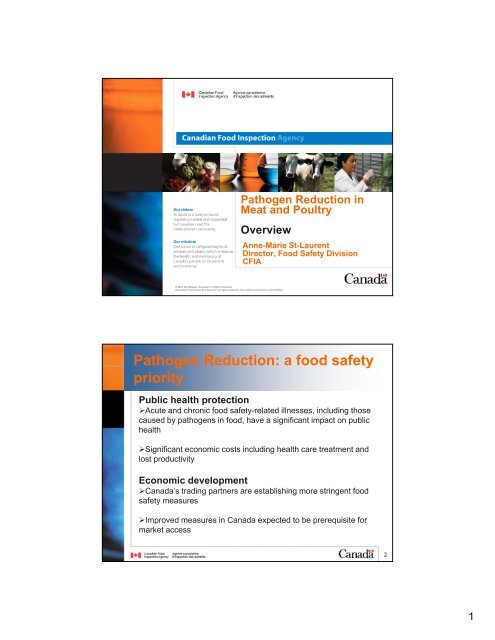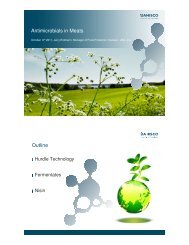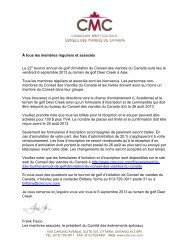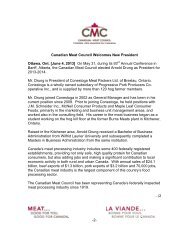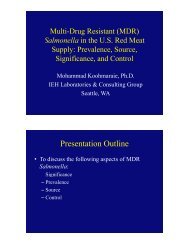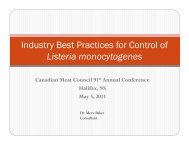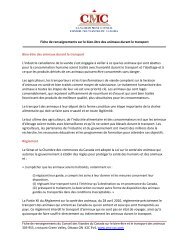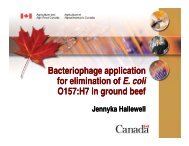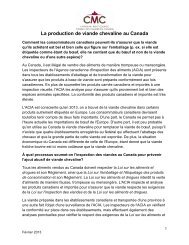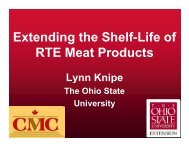Pathogen reduction initiative for Canada - Canadian Meat Council
Pathogen reduction initiative for Canada - Canadian Meat Council
Pathogen reduction initiative for Canada - Canadian Meat Council
You also want an ePaper? Increase the reach of your titles
YUMPU automatically turns print PDFs into web optimized ePapers that Google loves.
Action: <strong>Pathogen</strong> Reduction Initiative‣In February 2009, FPT Ministers of Agriculture tasked DeputyMinisters to develop an action plan to reduce pathogens in meatand poultry‣A FPT Working Group has been established to develop theaction plan consisting of representatives from CFIA, HC, PHAC,AAFC and provincial ministries of agriculture and health‣The objectives of the <strong>Pathogen</strong> Reduction Initiative are to:‣Benchmark <strong>Canada</strong>’s pathogen levels in meat and poultry‣Establish pathogen <strong>reduction</strong> targets‣Identify strategies to monitor and reduce pathogen levels5Current Status‣ Review pathogen <strong>reduction</strong> programs of key tradingpartners and identify best practices‣ Identify initial pathogen <strong>reduction</strong> priorities1. Salmonella and Campylobacter in chicken2. E. coli O157:H7 and other verotoxigenic E. coli (VTEC) onbeef carcasses, ground beef and trim3. Listeria monocytogenes in ready-to-eat meats‣ Designed the first two priority baseline studies‣ Initiation of stakeholder engagement – February 2011‣ Implementation of the first baseline study in 2012-201363
Microbiological Baseline Studies‣Studies designed to estimate current levels ofpathogens and indicator organisms across a targetpopulation against which trends in microbial levels canbe measured following implementation of interventions‣Baseline data are used to:‣ Demonstrate food safety per<strong>for</strong>mance to trading partners‣ Set per<strong>for</strong>mance standard (e.g. US) or pathogen <strong>reduction</strong>targets (e.g. EU, UK)‣ Evaluate the effectiveness of HACCP programs and interventionmeasures‣ Set guidelines <strong>for</strong> process control criteria (e.g. generic E. coli)7CAN studies on post-chill chicken carcasses•Baseline data from federally-registered establishments are outdated• No post-1997-98 study was conducted to evaluate the impact of FESP/HACCP• No baseline data on Campylobacter in poultry using US Food Safety and Inspection Service(FSIS) microbiological methods•Some provinces are moving <strong>for</strong>ward in updating their baseline dataSalmonellaCampylobacterStudy Time period Sample # % +ve Sample # % +veNationalAAFC 1983-86 670 60.9 410 38.2CFIA 1997-98 774 21.1 ND NDProvincialOntario 2001-02 1,480 31.6 1,469 63.9Quebec 2003-04 2,414 21.2 2,414 35.8Alberta 2004-05 1,295 37.5 1,234 75.0Ontario 2009-10 1,500 Ongoing 1,500 Ongoing84
US studies on post-chill chicken carcasses•A decrease in percent positive rate <strong>for</strong> Salmonella was observed following theinitial survey in 1994-95, but the rate remained unchanged after 2000•Baseline data from the last survey was used to set tighter Salmonella and newCampylobacter per<strong>for</strong>mance standards <strong>for</strong> chicken carcasses•Future US baseline surveys will be conducted at four-year interval or lessSampling Salmonella CampylobacterStudy Time period location Sample # % +ve Sample # % +veNationwideFSIS 1994-95 Post-chill 1,297 20.0 1,144 88.2FSIS 1999-00 Post-chill 1,225 8.7 ND NDFSIS 2007-08 Post-chill 3,275 8.2 2,926 40.2Re-hang 3,275 45.8 ND ND9Sampling locations <strong>for</strong> baseline studies onCampylobacter and Salmonella in broilersCampylobacterSalmonellaSamplinglocationsPer<strong>for</strong>mance targets by countryIS, SE NZ, US UKDK, EU, IS, SE EU, IS, SE, US UKFarm Processing RetailFlockprevalenceProductprevalenceSample typesSock samples, fecaldroppingsCarcass rinse, neckskin, caecaWhole and parts105
Proposed national microbiological baselinestudy in broiler chicken‣ Main objectives‣ To provide baseline data on prevalence and concentrations of Salmonella andCampylobacter in broiler chicken flocks, carcasses and retail chicken meatproducts‣ Specific objectives‣ Compare new baseline prevalence and concentrations of Salmonella in broilerchicken carcasses with 1997-98 baseline data‣ Evaluate the geographical distribution and seasonal variation of Salmonellaand Campylobacter in broiler chicken flocks grown on farms across <strong>Canada</strong>‣ Target population and products‣ Broiler farms (flocks sampled at abattoir)‣ Post-chill carcasses‣ Bulk packs containing a cluster of whole chicken carcasses (10-20)‣ Raw chicken meat products (food retail outlets)‣ Analytical methods‣ In-line with methods used in the last US baseline study in broiler chicken‣ Allow comparison of industry per<strong>for</strong>mance data with the baseline reference11Data reporting and Communications‣A final report will be published after the completion ofthe study‣Industry will be asked to review the final report be<strong>for</strong>epublic release‣Manuscripts will be submitted to peer-reviewed scientificjournals‣A communication strategy will be developed by theCFIA in consultation with governments and stakeholdersto effectively communicate the results of the baselinestudies126
Next Steps‣Development of baseline sampling program <strong>for</strong> Listeriain ready-to-eat meats‣Finalization of the Discussion Paper on Interventions <strong>for</strong>Salmonella and Campylobacter in Poultry‣Development of stakeholder engagement strategy‣Implementation l i of remaining i baseline samplingprograms‣Development and implementation of <strong>Pathogen</strong>Reduction Programs13Contact In<strong>for</strong>mationAnne-Marie St-LaurentDirector, Food Safety Division<strong>Canadian</strong> Food Inspection AgencyAnne-Marie.St-Laurent@inspection.gc.caDaniel LeclairChief, Food Microbiology Surveys<strong>Canadian</strong> Food Inspection AgencyDaniel.Leclair@inspection.gc.ca147


